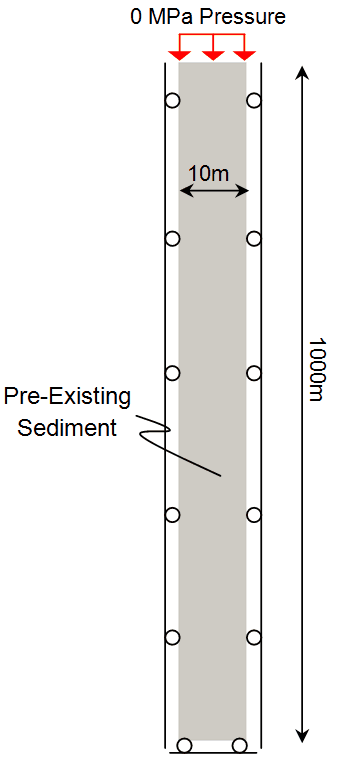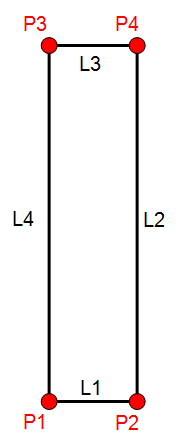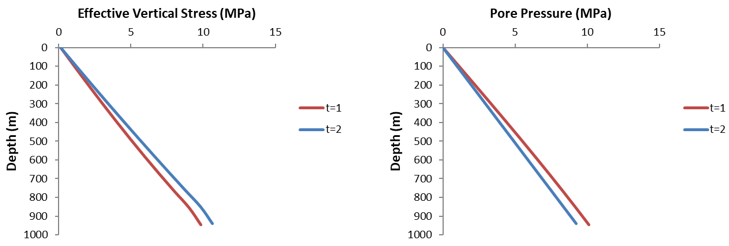Base Case 1 Permeability = 1E-18m2
Case 1: Problem Description
The objective is to simulate the sedimentation and consolidation of 1000m of sediment over a period of 1.0 Ma. The complete sediment column exists in the initial configuration and gravity is ramped up over 1.0 Ma. The model is analysed in uniaxial strain conditions; i.e. the vertical sides of the model are constrained in the horizontal direction, and the base of the model is constrained in the vertical direction. Gravity is the only load and the top surface of the model is prescribed zero pore pressure (pf); i.e. free drainage, resulting in a gradual dissipation of pore pressure in the model. A structured mesh of 40 linear quadrilateral (QPM4) elements is used.
Material Properties The material parameters corresponding to "HM_002_elastic" material are chosen to match the parameters assumed in the simulations presented by Wangen (2010, p.403). The primary mechanical properties for this material are:
The additional material parameters related to the porous flow field are:
Notes 1The simulation uses isotropic permeability. In general, however, soils exhibit transverse isotropic flow with the horizontal permeability often between 5 to 100 times larger than the vertical permeability. In this case orthotropic permeability may be defined via Permeability_x, Permeability_y and Permeability_z. Furthermore, permeability is dependent on the current porosity, so that in applications where significant compaction is used permeability is defined as a function of porosity. This may be either isotropic via Permeability_vs_porosity or orthotropic via Permeability_x_vs_porosity, Permeability_y_vs_porosity and Permeability_z_vs_porosity. 2The Biot constant (Biot_constant) defines the contribution of the pore pressure to the total stress via the effective stress relationship
The Biot constant may either be user defined (as in this case) or may be computed automatically via the relationship
3The material is specified as fully saturated ( Fluid_saturation = 1.0). 4The material is saturated with fluid name "Water".
Fluid Properties The properties of the pore fluid must be specified. The principal parameters are:
|
The initial data file for the project is: HM_002\Case1\Data\hm_002_Case1.dat. The basic data includes:
1Units defining stress in "MPa", length in "m", time in "Ma" and temperature in "Celsius". 2Geometry_set data defining model boundaries and domain. 3Mesh control (Mesh_control_data) and structured mesh generation data (Structured_mesh_data and Structured_line_set) defining a uniform mesh with 40 elements in the vertical direction. 4A single group which is assigned the "hm_002_elastic" material properties defined using Group_data and Group_control_data data structures. The Porous_flow_type = 4 i.e. a coupled geomechanical/porous flow. 5Material properties (Material_data) for "hm_002_elastic". 6Fluid properties (Fluid_properties) for water. 7Stratigraphy_definition and Stratigraphy_horizon to define the stratigraphy unit and top surface. Stratigraphy_surface_load to define a prescribed pore pressure condition (Pore_pressure_flag set to 1) on the top surface. 8Geostatic_data defining initial pore pressure of 0 MPa for the pre-existing sediment. 9Support_data defining geomechanical fixity constraints: base fixed vertically and sides fixed horizontally. 10Damping_global_data defining the use of combined damping models (percentage damping of 2%, i.e. 0.02 and bulk viscosity damping with constant of 0.5) to aid the numerical stability of the column model. 11History data: (a) Global history (History_global) data to output every porous flow increment the energies (dynamic response) for the complete domain. (b) Point history (History_point) data to output every porous flow increment the stresses, pore pressures, porosities, etc. at 11 points evenly distributed throughout the depth of the column. 12Solution control data via coupling control data (Couple_control_data) and geomechanical/porous flow control data (Porous_flow_control_data and Control_data) (see later).
|
The Group_control_data structure defines the active groups in each field. Generally all groups are active in all fields.
|
The Couple_control_data data structure defines the active fields for the analysis and additional data to control the coupling process. The data structure is only required if more than one field is active. The majority of the data may be assigned default values. For coupled hydro-mechanical simulations the default coupling scheme is:
1Fixed Stress algorithm 2Incremental staggered solution strategy 3Data exported from porous flow field: pore pressure and saturation 4Data exported from geomechanical field: coordinates, porosity
|
Coupling of the geomechanical and porous flow fields is achieved by treating the geomechanical field as an incremental analysis with the time step length corresponding to the time step of the porous flow field; i.e.
1A single porous flow step is performed for every coupling step. 2The geomechanical field is solved using an "Incremental" control option where multiple time steps are performed in each increment to achieve the explicit solution (dynamic relaxation) of the geomechanical field. This is necessary as the geomechanical and porous flow fields are "strongly coupled" due to the dependence of pore pressure on the volumetric strain rate.
The data controlling the solution strategy is specified via the Control_data (Geomechanical field) and Porous_flow_control_data (porous flow field) data structures.
|
The result files for the project are in directory: HM_002\Case1\Results . The high definition history files are displayed graphically in the excel file HM_002\00_hm_002.xlsx "hm_002_Case1" worksheet.
The evolution of pore pressure and effective vertical and horizontal stresses are shown below. The predicted maximum overpressure at the base of the column is ca. 1.12 MPa which is lower than the analytical prediction of 1.33 MPa. This is expected and is due to the assumption in the analytical solution to ignore any geometrical compaction, i.e. the analytical solution is based on the original column height of 1000m whereas in the numerical solution, the 1000m column has compacted to a height of 946m after 1Ma.
Pore Pressure Evolution at the Base of the Column as a Function of Time
Effective Vertical Stress and Pore Pressure with Depth at t = 1Ma and t = 2Ma
|






